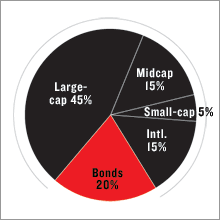The Riveras: Married, with a windfallA $100,000 surprise created a dilemma: mutual funds or real estate? See how they can achieve long-term growth without stomach-churning risk.NEW YORK (Money Magazine) -- When Cynthia Centeno and Richard Rivera started dating, they quickly realized they had a lot in common. Both had grown up in the Bronx, earned master's degrees in public administration and pursued careers in the nonprofit world. One area where they differed was money. Centeno was a saver who believed any debt was bad, whereas Rivera got his first piece of plastic in college and owed $20,000 on five credit cards.
But after they decided to marry and their daughter Indira, now 7, was on the way, Rivera knew he had to make some changes. "Having our daughter made me rethink how I spend money and the importance of saving," he says. Today both Rivera, 38, and Centeno, 34, are dedicated savers. The couple have pared down their debt to $3,000, stashed $20,000 for Indira's college education in a 529 plan and built up $35,000 in a bank account. And, as if their conversion to frugality weren't its own reward, last year they received a pleasant surprise: An elderly family friend unexpectedly left them a sizable inheritance. They put $110,000 in a certificate of deposit, which is coming due soon, forcing a decision. "It's a lot of money to us, and we're unsure how to invest it," says Centeno. Where they are now Rivera and Centeno, who hope to retire in their early sixties, believe that real estate is the key to wealth. They own two houses, one in Florida and another in North Carolina, as well as their apartment in the upscale Riverdale section of the Bronx. Their goal is to buy another investment property each year. All together, they have about $390,000 in real estate equity. "We just don't think our incomes and retirement plans will be enough to give us the financial future we want," says Rivera. That's why they've been far less ambitious about investing in their employer's retirement plans. Rivera, a director of college prep programs for minority high school students, puts $6,000 a year into his 403(b), enough to get his employer's match. So far he's saved just $60,000. Before Centeno left her job last September to study full time to become a speech pathologist, she had built up only $10,000 in her 403(b). A full scholarship will cover her $70,000 total tuition, but the couple will be living on half their former $145,000 income for the next few years. With 40 percent of their money tied up in investment properties, Centeno and Rivera have too much real estate, says Manhattan financial planner Lauren Prince. Although the rent from the properties covers the mortgages and related expenses, "being a long-distance landlord is risky," Prince says. "There are so many potential costs, like maintenance and unexpected vacancies. Plus, we don't know if housing prices will continue to go up." What they should do To start, Prince suggests that Centeno and Rivera stop buying homes and add to their stock and bond portfolio instead. That portfolio will get a major jump-start from the inheritance, now worth $113,000 with interest. First, Rivera and Centeno should use $3,000 to pay off their credit-card debt and $8,000 to fully fund Roth IRAs this year. Next they should make a $12,000 contribution to Indira's 529 college savings plan, investing it in a highgrowth portfolio largely made up of stocks. The pair should put the rest of the inheritance (about $90,000) in a high-interest savings account such as ING Direct's and gradually invest it over the next two years, says Prince. Buying stocks bit by bit will insulate their portfolio from the market's ups and downs, as well as give them a cash cushion for emergencies while Centeno is in school. They won't be retiring for several decades, so Prince suggests they maximize growth by keeping 80 percent of their portfolio in stocks. Since Centeno is nervous about stock market risk, Prince thinks they should keep a portion of their equity holding in value-oriented actively managed Money 70 funds such as Selected American (SLASX (Charts) and T. Rowe Price Blue Chip Growth (TRBCX (Charts), which have the potential to beat the overall stock market but typically don't lose as much in a downturn. Rivera's current 80-20 stock-bond mix in his 403(b) is fine, says Prince. But Centeno should transfer the $8,000 in her former employer's 403(b) plan to an IRA to give her more investment options. They should continue to fund IRAs each year, and once Centeno is working full time again, they both should max out contributions to their retirement plans. If they follow this plan, Prince estimates, they'll have no trouble meeting their goal of retiring in their early sixties. Centeno and Rivera are still enamored of real estate, but agree that the market is the right place for the inheritance. "It will be nice to have that money when we retire," says Centeno. The Money 70: Best funds you can own More Makeovers: Brian and Kim O'Donnell: Starting out in hock Marilyn Cazayoux: Playing catch-up |
| ||||||||


